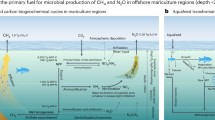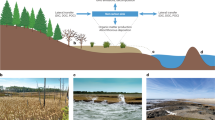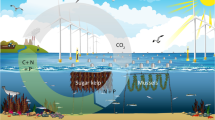Abstract
Coastal wetlands offer large carbon sequestration benefits but their conversion to aquaculture systems could result in substantial carbon losses. Here we show that the conversion of Spartina alterniflora salt marsh to mariculture ponds in China generated a greenhouse gas (GHG) footprint of 20.3 Mg CO2 equivalent per ha per year. Around two-thirds of the footprint can be attributed to foregone salt marsh GHG mitigation capacity, whereas direct carbon dioxide, methane and nitrous oxide emissions in mariculture ponds account for only ~10%, with the remaining ~20% arising from feed, fertilizer and energy consumption. Aquaculture can offer comparatively lower GHG footprints than other animal protein sources, such as terrestrial beef and small ruminants’ production on a kg CO2 equivalent per kg protein basis, but this assumption may not be accurate when considering landscape-scale changes in GHG budgets, particularly in relation to the expansion of aquaculture within blue carbon ecosystems.
This is a preview of subscription content, access via your institution
Access options
Access Nature and 54 other Nature Portfolio journals
Get Nature+, our best-value online-access subscription
$32.99 / 30 days
cancel any time
Subscribe to this journal
Receive 12 digital issues and online access to articles
$119.00 per year
only $9.92 per issue
Buy this article
- Purchase on SpringerLink
- Instant access to full article PDF
Prices may be subject to local taxes which are calculated during checkout





Similar content being viewed by others
Data availability
All data needed to evaluate the conclusions are present in the paper and/or in the Supplementary Information. Emissions factors for applied fertilizers, feeds and energy in Chinese aquaculture systems, and those for commercial feed ingredients, were primarily derived via the China Products Carbon Footprint Factors Database (CPCD) at https://lca.cityghg.com/. Source data are provided with this paper.
Code availability
Code used to reproduce findings of this work can be obtained via Code Ocean at https://doi.org/10.24433/CO.6642099.v2.
References
Kirwan, M. L. & Megonigal, J. P. Tidal wetland stability in the face of human impacts and sea-level rise. Nature 504, 53–60 (2013).
Mcleod, E. et al. A blueprint for blue carbon: toward an improved understanding of the role of vegetated coastal habitats in sequestering CO2. Front. Ecol. Environ. 9, 552–560 (2011).
Duarte, C. M., Losada, I. J., Hendriks, I. E., Mazarrasa, I. & Marbà, N. The role of coastal plant communities for climate change mitigation and adaptation. Nat. Clim. Change 3, 961–968 (2013).
Lovelock, C. E. et al. The vulnerability of Indo-Pacific mangrove forests to sea-level rise. Nature 526, 559–563 (2015).
Ma, Z. et al. Rethinking China’s new great wall. Science 346, 912–914 (2014).
Richards, D. R. & Friess, D. A. Rates and drivers of mangrove deforestation in Southeast Asia, 2000–2012. Proc. Natl Acad. Sci. USA 113, 344–349 (2016).
Barbier, E. B. et al. The value of estuarine and coastal ecosystem services. Ecol. Monogr. 81, 169–193 (2011).
Murdiyarso, D. et al. The potential of Indonesian mangrove forests for global climate change mitigation. Nat. Clim. Change 5, 1089–1092 (2015).
Ren, C. et al. Rapid expansion of coastal aquaculture ponds in China from Landsat observations during 1984–2016. Int. J. Appl. Earth Obs. Geoinform. 82, 101902 (2019).
FAO The State of World Fisheries and Aquaculture 2020: Sustainability in Action (FAO Fisheries and Aquaculture Department, 2020).
FAO The State of World Fisheries and Aquaculture 2014: Opportunities and Challenges (FAO Fisheries and Aquaculture Department, 2014).
Kauffman, J. B., Heider, C., Norfolk, J. & Payton, F. Carbon stocks of intact mangroves and carbon emissions arising from their conversion in the Dominican Republic. Ecol. Appl. 24, 518–527 (2014).
Cao, L., Diana, J. S., Keoleian, G. A. & Lai, Q. Life cycle assessment of Chinese shrimp farming systems targeted for export and domestic sales. Environ. Sci. Technol. 45, 6531–6538 (2011).
Hargreaves, J. A. Nitrogen biogeochemistry of aquaculture ponds. Aquaculture 166, 181–212 (1998).
Yuan, J. et al. Rapid growth in greenhouse gas emissions from the adoption of industrial-scale aquaculture. Nat. Clim. Change 9, 318–322 (2019).
Yang, P. et al. Effects of coastal marsh conversion to shrimp aquaculture ponds on CH4 and N2O emissions. Estuarine Coastal Shelf Sci. 199, 125–131 (2017).
Stocker, T. F. et al. Climate Change 2013: The Physical Science Basis (Cambridge University Press, Cambridge, 2013).
Verdegem, M. C. J. & Bosma, R. H. Water withdrawal for brackish and inland aquaculture, and options to produce more fish in ponds with present water use. Water Policy 11, 52–68 (2009).
Wang, J. et al. Ecosystem carbon exchange across China’s coastal wetlands: spatial patterns, mechanisms, and magnitudes. Agric. For. Meteorol. 345, 109859 (2024).
Zhang, D. et al. Carbon dioxide fluxes from two typical mariculture polyculture systems in coastal China. Aquaculture 521, 735041 (2020).
Yang, P. et al. Insights into the farming-season carbon budget of coastal earthen aquaculture ponds in southeastern China. Agric. Ecosyst. Environ. 335, 107995 (2022).
Kosten, S. et al. Better assessments of greenhouse gas emissions from global fish ponds needed to adequately evaluate aquaculture footprint. Sci. Total Environ. 748, 141247 (2020).
Barros, N. et al. Carbon emission from hydroelectric reservoirs linked to reservoir age and latitude. Nat. Geosci. 4, 593–596 (2011).
Zhang, J., Song, C. & Wenyan, Y. Tillage effects on soil carbon fractions in the Sanjiang Plain, Northeast China. Soil Tillage Res. 93, 102–108 (2007).
Zhang, K., Tian, X., Dong, S., Feng, J. & He, R. An experimental study on the budget of organic carbon in polyculture systems of swimming crab with white shrimp and short-necked clam. Aquaculture 451, 58–64 (2016).
Ström, L., Ekberg, A., Mastepanov, M. & Christensen, T. R. The effect of vascular plants on carbon turnover and methane emissions from a tundra wetland. Glob. Change Biol. 9, 1185–1192 (2003).
Tokida, T. et al. Falling atmospheric pressure as a trigger for methane ebullition from peatland. Glob. Biogeochem. Cycles 21, GB2003 (2007).
Bastviken, D., Cole, J., Pace, M. & Tranvik, L. Methane emissions from lakes: dependence of lake characteristics, two regional assessments, and a global estimate. Glob. Biogeochem. Cycles 18, GB4009 (2004).
Al-Haj, A. N. & Fulweiler, R. W. A synthesis of methane emissions from shallow vegetated coastal ecosystems. Glob. Change Biol. 26, 2988–3005 (2020).
Moseman-Valtierra, S. et al. Short-term nitrogen additions can shift a coastal wetland from a sink to a source of N2O. Atmos. Environ. 45, 4390–4397 (2011).
Miller, M. N. et al. Crop residue influence on denitrification, N2O emissions and denitrifier community abundance in soil. Soil Biol. Biochem. 40, 2553–2562 (2008).
Avnimelech, Y. Carbon/nitrogen ratio as a control element in aquaculture systems. Aquaculture 176, 227–235 (1999).
Hu, Z. et al. Influence of carbohydrate addition on nitrogen transformations and greenhouse gas emissions of intensive aquaculture system. Sci. Total Environ. 470, 193–200 (2014).
Liu, S. et al. Methane and nitrous oxide emissions reduced following conversion of rice paddies to inland crab-fish aquaculture in Southeast China. Environ. Sci. Technol. 50, 633–642 (2016).
Yang, P. et al. Spatial variations of N O fluxes across the water–air interface of mariculture ponds in a subtropical estuary in Southeast China. J. Geophys. Res. Biogeosciences 125, e2019JG005605 (2020).
Ma, Y. et al. A comparison of methane and nitrous oxide emissions from inland mixed-fish and crab aquaculture ponds. Sci. Total Environ. 637–638, 517–523 (2018).
Murray, R. H., Erler, D. V. & Eyre, B. D. Nitrous oxide fluxes in estuarine environments: response to global change. Glob. Change Biol. 21, 3219–3245 (2015).
Hu, Z., Lee, J. W., Chandran, K., Kim, S. & Khanal, S. K. Nitrous oxide (N2O) emission from aquaculture: a review. Environ. Sci. Technol. 46, 6470–6480 (2012).
Williams, J. & Crutzen, P. Nitrous oxide from aquaculture. Nat. Geosci. 3, 14 (2010).
Neubauer, S. C. & Megonigal, J. P. Moving beyond global warming potentials to quantify the climatic role of ecosystems. Ecosystems 18, 1000–1013 (2015).
Yang, P. et al. Assessing nutrient budgets and environmental impacts of coastal land-based aquaculture system in southeastern China. Agric. Ecosyst. Environ. 322, 107662 (2021).
Yuan, J. et al. Methane and nitrous oxide have separated production zones and distinct emission pathways in freshwater aquaculture ponds. Water Res. 190, 116739 (2021).
Ondiek, R. et al. Influence of land-use change and season on soil greenhouse gas emissions from a tropical wetland: a stepwise explorative assessment. Sci. Total Environ. 787, 147701 (2021).
Meijide, A. et al. Measured greenhouse gas budgets challenge emission savings from palm-oil biodiesel. Nat. Commun. 11, 1089 (2020).
Maxwell, S. L. et al. Degradation and forgone removals increase the carbon impact of intact forest loss by 626%. Sci. Adv. 5, eaax2546 (2019).
Rosentreter, J. A., Al-Haj, A. N., Fulweiler, R. W. & Williamson, P. Methane and nitrous oxide emissions complicate coastal blue carbon assessments. Glob. Biogeochem. Cycles 35, e2020GB006858 (2021).
Schutte, C. A., Moore, W. S., Wilson, A. M. & Joye, S. B. Groundwater-driven methane export reduces salt marsh blue carbon potential. Glob. Biogeochem. Cycles 34, e2020GB006587 (2020).
Maher, D. T., Call, M., Santos, I. R. & Sanders, C. J. Beyond burial: lateral exchange is a significant atmospheric carbon sink in mangrove forests. Biol. Lett. 14, 20180200 (2018).
MacLeod, M. J., Hasan, M. R., Robb, D. H. & Mamun-Ur-Rashid, M. Quantifying greenhouse gas emissions from global aquaculture. Sci. Rep. 10, 11679 (2020).
Liu, C. et al. Habitat changes for breeding waterbirds in Yancheng National Nature Reserve, China: a remote sensing study. Wetlands 30, 879–888 (2010).
Reichstein, M. et al. On the separation of net ecosystem exchange into assimilation and ecosystem respiration: review and improved algorithm. Glob. Change Biol. 11, 1424–1439 (2005).
Kroon, P. S. et al. Uncertainties in eddy covariance flux measurements assessed from CH4 and N2O observations. Agric. For. Meteorol. 150, 806–816 (2010).
Yuan, J. et al. Exotic Spartina alterniflora invasion alters ecosystem–atmosphere exchange of CH4 and N2O and carbon sequestration in a coastal salt marsh in China. Glob. Change Biol. 21, 1567–1580 (2015).
Chang, C. C., Chang, K. C., Lin, W. C. & Wu, M. H. Carbon footprint analysis in the aquaculture industry: assessment of an ecological shrimp farm. J. Cleaner Prod. 168, 1101–1107 (2017).
China City Greenhouse Gas Working Group China Products Carbon Footprint Factors Database (2022) (Beijing, 2022).
Ray, N. E., Maguire, T. J., Al-Haj, A. N., Henning, M. C. & Fulweiler, R. W. Low greenhouse gas emissions from oyster aquaculture. Environ. Sci. Technol. 53, 9118–9127 (2019).
Acknowledgements
This work was financially supported by the National Natural Science Foundation of China (grants 42322709, 42177301, U24A20628), the Natural Science Foundation (BK20230050) and Carbon Peak and Carbon Neutral Science and Technology Innovation Project of Jiangsu Province (BK20220020) and the Chinese Academy of Sciences Project for Young Scientists in Basic Research (YSBR-089).
Author information
Authors and Affiliations
Contributions
W.D., J.Y. and D.L. designed the research. J.Y., Y.D., J.L., J.X., T.H. and H.K. performed the data extraction and analysis. J.Y. wrote the first draft of the paper, with all authors contributing to the revisions.
Corresponding author
Ethics declarations
Competing interests
The authors declare no competing interests.
Peer review
Peer review information
Nature Food thanks Shuijin Hu, Shuwei Liu and Nicholas Ray for their contribution to the peer review process.
Additional information
Publisher’s note Springer Nature remains neutral with regard to jurisdictional claims in published maps and institutional affiliations.
Supplementary information
Supplementary Information
Supplementary Text 1, Figs. 1–4 and Tables 1–9.
Supplementary Data 1
Source data for Supplementary Figs. 2–4.
Source data
Source Data Fig. 2
Source data for Fig. 2a–f.
Source Data Fig. 3
Source data for Fig. 3a–d.
Source Data Fig. 5
Source data for Fig. 5a–c.
Rights and permissions
Springer Nature or its licensor (e.g. a society or other partner) holds exclusive rights to this article under a publishing agreement with the author(s) or other rightsholder(s); author self-archiving of the accepted manuscript version of this article is solely governed by the terms of such publishing agreement and applicable law.
About this article
Cite this article
Yuan, J., Dong, Y., Li, J. et al. Foregone carbon sequestration dominates greenhouse gas footprint in aquaculture associated with coastal wetland conversion. Nat Food 6, 587–596 (2025). https://doi.org/10.1038/s43016-025-01156-5
Received:
Accepted:
Published:
Issue date:
DOI: https://doi.org/10.1038/s43016-025-01156-5



